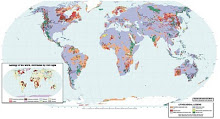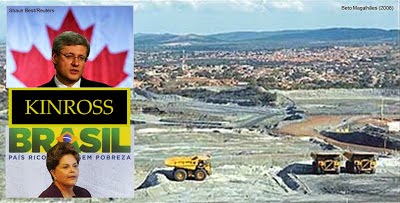*United Nations Synthesis Report on Arsenic in Drinking-Water*
*By various authors*
*WHO, 2001*
* *
*Accessible from:
http://www.who.int/water_sanitation_health/dwq/arsenic3/en/*
* *
*- HIGHLIGHTS (bearing on the Paracatu issue, MG, Brazil) -*
* *
*"In areas where some geological units are arseniferous and others are not, it is important to avoid cross-contamination, which can occur in several ways. In some cases, the arsenic-rich zones may be naturally in hydraulic connection with arsenic -free zones. By pumping water from arsenic -free zones, arsenic -rich water may be induced to flow into previously uncontaminated strata, and eventually may reach the well." *
* *
*"(...) in many soils and aquifers, much of the arsenic appears to be associated with secondary minerals such as iron, aluminium and manganese oxides, probably in large part as adsorbed arsenic species. This form is particularly sensitive to changes in the environment and it only takes a small change in the amount of arsenic adsorbed to change the concentration of arsenic in the groundwater significantly. For example, if it assumed that say 1 mg kg-1 of the sediment arsenic is present in a labile form, in the event of complete dissolution or desorption, this would produce up to 3000-6000 ì**g As l-1 in the groundwater, many times the WHO guideline value."*
* *
*"An important consequence of the highly non-linear adsorption for arsenate is that even at the ì**g l-1 level of arsenic in solution, the arsenic loading on the oxide can be appreciable corresponding to thousands of mg As/kg in the case of hydrous ferric oxide (Hfo)."*
* *
*"Significant increases in arsenic concentrations of river waters may also occur as a result of pollution from industrial or sewage effluents." *
* *
* "Arsenic concentrations much higher than baseline values have been found in sediments and soils contaminated by the products of mining activity, including mine tailings and effluent. Concentrations in tailings piles and tailings-contaminated soils can reach up to several thousand mg kg-1. The high concentrations reflect not only increased abundance of primary arsenic -rich sulphide minerals, but also secondary iron arsenates and iron oxides formed as reaction products of the original ore minerals. The primary sulphide minerals are susceptible to oxidation in the tailings pile and the secondary minerals have varying solubility in oxidising conditions in groundwaters and surface waters. Scorodite (FeAsO4.2H2O) is a common sulphide oxidation product and its solubility is considered to control arsenic concentrations in such oxidising sulphide environments. Scorodite is metastable under most groundwater conditions and tends to dissolve incongruently, forming iron oxides and releasing arsenic into solution (Robins, 1987; Kraus and Ettel, 1989)."*
* *
*"Azcue and Nriagu (1995) found baseline concentrations in the Moira River, Ontario of 0.7 ì**g l-1 upstream of the influence of tailings from gold-mine workings. Downstream, concentrations increased to 23 ì**g l-1. Azcue et al. (1994) found concentrations up to 556 ì**g l-1 (average 17.5 ì**g l-1) in streams adjacent to tailings deposits in British Columbia. Williams et al. (1996) and Smedley et al. (1996) noted high arsenic concentrations (typically around 200-300 ì**g l-1) in surface waters affected respectively by tin- and gold- mining activities." *
* *
*"As with Ron Phibun District in Thailand, the gold is associated with sulphide mineralisation, particularly arsenopyrite. Arsenic mobilises in the local environment as a result of arsenopyrite oxidation, induced (or exacerbated) by the mining activity. Around the town of Obuasi, high As concentrations have been noted in soils close to the mines and treatment works (Amasa, 1975; Bowell, 1992; 1993). Some high concentrations have also been reported in river waters close to the mining activity (Smedley et al., 1996)."*
* *
*"In the cases where affected groundwaters are found close to obvious geological or industrial sources rich in arsenic (geothermal springs, drainage from mineralised and mining areas, specific contaminant sources), it is clear that the anomalously high arsenic concentrations in the source region are responsible."*
* *
*"The greater the quantity of arsenic involved, the more strongly it is adsorbed and the slower the rate of groundwater movement, the longer that high-arsenic groundwaters will persist".*
* *
*"Significant changes in arsenic transport in groundwater may occur locally due to the influence of mining, groundwater pumping and irrigation. Mining in hardrock areas may in effect create a new aquifer with extensive fracturing, adits and other drainage channels. The water table is also often lowered by drainage or pumping and this can induce air entry and enhanced oxidation."*
* *
*"The mobilisation of As is believed to be caused by oxidation of arsenopyrite, exacerbated by the former tin- mining activities. The recent appearance in groundwater has occurred during post- mining groundwater rebound (Williams, 1997)."*
* *
*"Arsenic is unusual in that sufficient human epidemiological data of acceptable scientific quality are available for the assessment of health risks associated with the long-term exposure to arsenic. Long-term exposure to arsenic in drinking water is causally related to increased risks of cancer in the skin, lungs, bladder and kidney, as well as other skin changes such as hyperkeratosis and pigmentation changes. These effects have been clearly demonstrated in a number of epidemiological studies of differing design. High risks and exposure-dose relationships have been observed for each of these end-points."*
* *
*"A few epidemiological studies have highlighted that none of the exposed population to environmental As show any clinical manifestation of chronic As toxicity. (Goldsmith 1980. Harrington et al 1978. Valentine et al 1985). Further, there is a wide variation in the incidence of chronic arsenicosis in an affected population. Even not all members of an affected family show clinical effect. The reasons for such variation of disease expression is an enigma. However, as the As exposed people are at risk for developing As related cancer, they should be subjected to prolonged surveillance."*
* *
*"Raie (1996) compared tissue arsenic levels in infants (aged 1 day to 5 months) and adults from Glasgow, Scotland using NAA. Mean levels of arsenic (ppm or ug/g dry weight) in liver, lung and spleen in infants versus adults were 0.0099 vs. 0.048, 0.007 vs. 0.044, and 0.0049 vs. 0.015, respectively. These data suggest that arsenic accumulates in tissues with age, a finding that is wholly consistent with observations in laboratory animals (Marafante et al., 1982)."*
* *
*"In spite of the higher risk of contamination, in many cases surface water is the only feasible water source, and various low-cost , low-tech options for water treatment are available." *
* *
*"The mitigation strategy for arsenic contamination can entail arsenic removal, but because of the costs and operational complexity of the technologies involved, it is often preferable to seek an alternative water source of good quality."*
* *
*"Given that arsenic removal is prohibitively expensive in many circumstances, much will depend on the availability of feasible alternative water sources."*
* *
*"The best treatment strategy when symptoms start emerging is the provision of arsenic -free water." *
* *
*"It is now clear that the chronic effects of low concentrations of arsenic in drinking water have been underestimated. Large populations in various parts of the world are exposed to levels of arsenic above safe limits. The full epidemiological implications of arsenic contamination are only now emerging, and it is likely that over the coming decade more arsenicosis cases will be identified. This adds substantially to the complexity of water service provision. Arsenic removal is - in general - expensive and technically difficult, and alternative water sources may either be unavailable or can pose their own serious health risks (such as increased diarrhoeal disease incidence)." *
* *
*"Many of the worst problems occur in poor countries without the necessary infrastructure to be able to respond rapidly."*
* *
*"What is clear is that the poor, and especially the rural poor, are the most vulnerable."*
* *
*"If the water supply is of good quality and replaces old contaminated wells or supplies, it also contributes towards improvements in public health. Finally, water is increasingly seen by many to be a basic human right and thus the provision of water to all, at a reasonable cost, is an imperative that must be fulfilled by governments and other duty-bearers (see, for example, Article 24 of the Convention of the Rights of the Child -United Nations 1989)."*
Sunday, October 11, 2009
Subscribe to:
Post Comments (Atom)




No comments:
Post a Comment